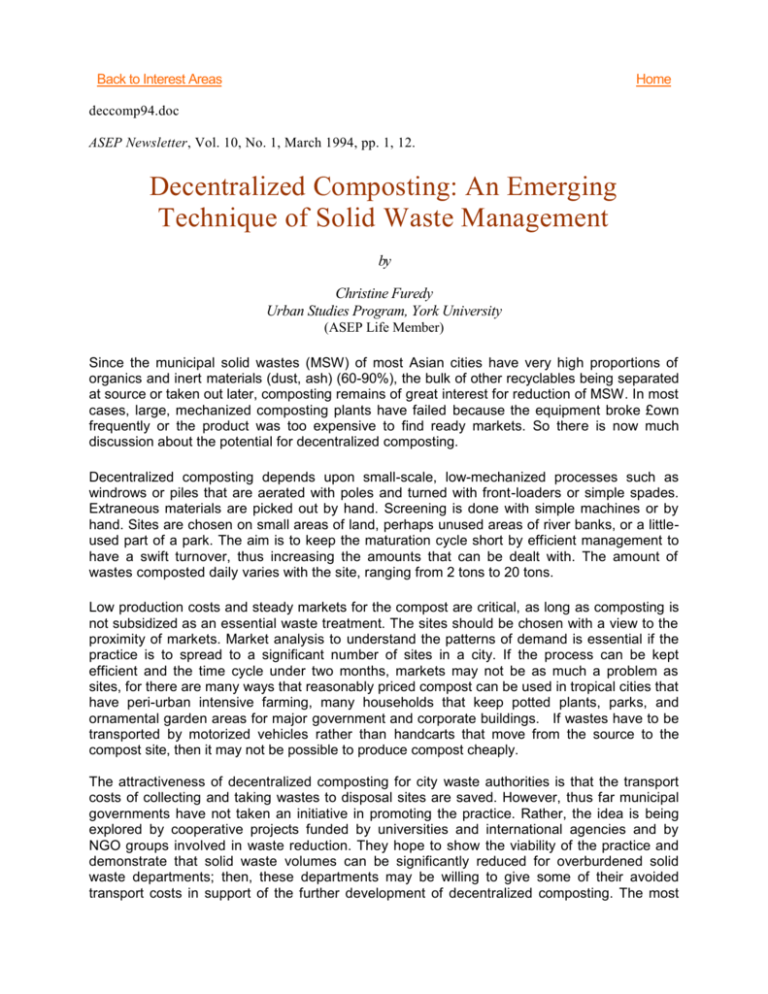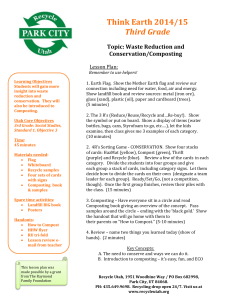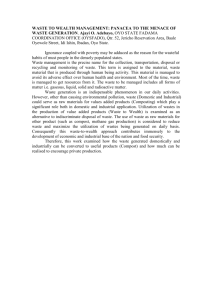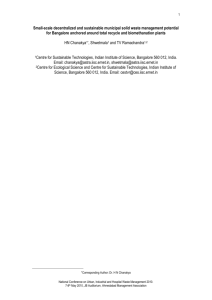Decentralized Composting: An Emerging Techniue
advertisement

Back to Interest Areas Home deccomp94.doc ASEP Newsletter, Vol. 10, No. 1, March 1994, pp. 1, 12. Decentralized Composting: An Emerging Technique of Solid Waste Management by Christine Furedy Urban Studies Program, York University (ASEP Life Member) Since the municipal solid wastes (MSW) of most Asian cities have very high proportions of organics and inert materials (dust, ash) (60-90%), the bulk of other recyclables being separated at source or taken out later, composting remains of great interest for reduction of MSW. In most cases, large, mechanized composting plants have failed because the equipment broke £own frequently or the product was too expensive to find ready markets. So there is now much discussion about the potential for decentralized composting. Decentralized composting depends upon small-scale, low-mechanized processes such as windrows or piles that are aerated with poles and turned with front-loaders or simple spades. Extraneous materials are picked out by hand. Screening is done with simple machines or by hand. Sites are chosen on small areas of land, perhaps unused areas of river banks, or a littleused part of a park. The aim is to keep the maturation cycle short by efficient management to have a swift turnover, thus increasing the amounts that can be dealt with. The amount of wastes composted daily varies with the site, ranging from 2 tons to 20 tons. Low production costs and steady markets for the compost are critical, as long as composting is not subsidized as an essential waste treatment. The sites should be chosen with a view to the proximity of markets. Market analysis to understand the patterns of demand is essential if the practice is to spread to a significant number of sites in a city. If the process can be kept efficient and the time cycle under two months, markets may not be as much a problem as sites, for there are many ways that reasonably priced compost can be used in tropical cities that have peri-urban intensive farming, many households that keep potted plants, parks, and ornamental garden areas for major government and corporate buildings. If wastes have to be transported by motorized vehicles rather than handcarts that move from the source to the compost site, then it may not be possible to produce compost cheaply. The attractiveness of decentralized composting for city waste authorities is that the transport costs of collecting and taking wastes to disposal sites are saved. However, thus far municipal governments have not taken an initiative in promoting the practice. Rather, the idea is being explored by cooperative projects funded by universities and international agencies and by NGO groups involved in waste reduction. They hope to show the viability of the practice and demonstrate that solid waste volumes can be significantly reduced for overburdened solid waste departments; then, these departments may be willing to give some of their avoided transport costs in support of the further development of decentralized composting. The most work on these lines has been done in Java, Indonesia. The leading work has been done in the cooperative project of the Harvard Institute of International Development and the Center for Policy Implementation Studies in Jakarta. The techniques developed in this project for swift turnover (50 days) and market exploitation were based on careful study of the waste recoveryrecycling system of the city and thorough technical experiments. Working with very much less financial and technical support, either local or international, Waste Wise, a community-based organization in Bangalore, has demonstrated the concept of decentralized composting in a local park. The Bangalore City Corporation has made the space available for several compost pits, and Waste Wise has organized teams of collectors to bring the organic wastes from about 100 households that are participating in the experiment. Worm growing is being tried in conjunction with composting. The Linis Ganda Project of the Metro Manila Council of the Women's Balikatan Movement is to receive World Bank assistance for their project in compost-making, which will also involve charcoal production from garden wastes Another initiative is being sponsored by the United Nations Center for Human Settlements, where funds have been allocated for the development of a small-scale composter-digester designed for use in congested areas. Once the equipment has been tested in the "shop" it will be tried in the field in three cities, and training programs will be designed to assist local efforts to promote the adoption of the equipment. Some of the difficulties that the concept faces in practice, besides finding appropriate sites and selling the compost steadily at a price that is profitable, are building and maintaining adequate infrastructure, recruiting and training competent staff at each site, and controlling vermin. The rat problem arises because the waste materials are usually mixed household and market wastes, not ones that have been carefully source-separated for ideal composting. Thus, there are usually food wastes present that attract rats. This may not be a problem if the compost site is a little-used river bank, but rats can be a hazard for parks and are certainly unwelcome in congested residential areas. The projects that have started so far are recording their own progress; there are now enough such projects to allow some comparison of results. Such comparison, and further research, will need the support of an international funding agency. Broader research on the composting techniques, the quality of the compost, the rat problem, the potential of vermiculture (is it worth the extra work?), and the long-term environmental effects of concentrating compost from household wastes in certain areas such as parks will be necessary to assess the pros and cons of decentralized composting as a basic technique of solid waste management in tropical cities. □









